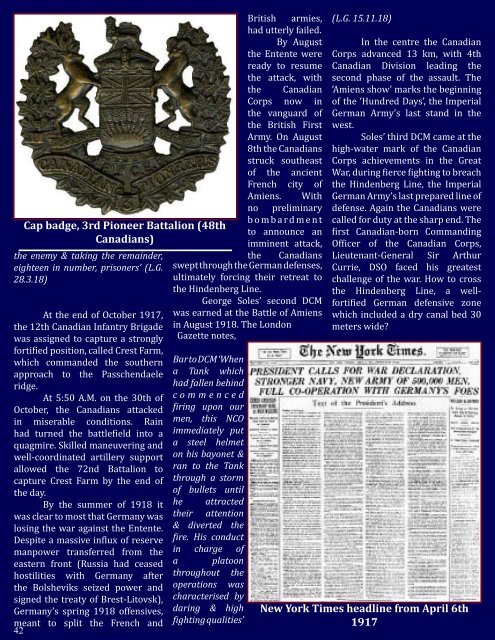Cabar Feidh
Cabar Feidh19OCT15
Cabar Feidh19OCT15
You also want an ePaper? Increase the reach of your titles
YUMPU automatically turns print PDFs into web optimized ePapers that Google loves.
Cap badge, 3rd Pioneer Battalion (48th<br />
Canadians)<br />
the enemy & taking the remainder,<br />
eighteen in number, prisoners’ (L.G.<br />
28.3.18)<br />
At the end of October 1917,<br />
the 12th Canadian Infantry Brigade<br />
was assigned to capture a strongly<br />
fortified position, called Crest Farm,<br />
which commanded the southern<br />
approach to the Passchendaele<br />
ridge.<br />
At 5:50 A.M. on the 30th of<br />
October, the Canadians attacked<br />
in miserable conditions. Rain<br />
had turned the battlefield into a<br />
quagmire. Skilled maneuvering and<br />
well-coordinated artillery support<br />
allowed the 72nd Battalion to<br />
capture Crest Farm by the end of<br />
the day.<br />
By the summer of 1918 it<br />
was clear to most that Germany was<br />
losing the war against the Entente.<br />
Despite a massive influx of reserve<br />
manpower transferred from the<br />
eastern front (Russia had ceased<br />
hostilities with Germany after<br />
the Bolsheviks seized power and<br />
signed the treaty of Brest-Litovsk),<br />
Germany’s spring 1918 offensives,<br />
meant to split the French and<br />
42<br />
British armies,<br />
had utterly failed.<br />
By August<br />
the Entente were<br />
ready to resume<br />
the attack, with<br />
the Canadian<br />
Corps now in<br />
the vanguard of<br />
the British First<br />
Army. On August<br />
8th the Canadians<br />
struck southeast<br />
of the ancient<br />
French city of<br />
Amiens. With<br />
no preliminary<br />
bombardment<br />
to announce an<br />
imminent attack,<br />
the Canadians<br />
swept through the German defenses,<br />
ultimately forcing their retreat to<br />
the Hindenberg Line.<br />
George Soles’ second DCM<br />
was earned at the Battle of Amiens<br />
in August 1918. The London<br />
Gazette notes,<br />
Bar to DCM ‘When<br />
a Tank which<br />
had fallen behind<br />
commenced<br />
firing upon our<br />
men, this NCO<br />
immediately put<br />
a steel helmet<br />
on his bayonet &<br />
ran to the Tank<br />
through a storm<br />
of bullets until<br />
he attracted<br />
their attention<br />
& diverted the<br />
fire. His conduct<br />
in charge of<br />
a platoon<br />
throughout the<br />
operations was<br />
characterised by<br />
daring & high<br />
fighting qualities’<br />
(L.G. 15.11.18)<br />
In the centre the Canadian<br />
Corps advanced 13 km, with 4th<br />
Canadian Division leading the<br />
second phase of the assault. The<br />
‘Amiens show’ marks the beginning<br />
of the ‘Hundred Days’, the Imperial<br />
German Army’s last stand in the<br />
west.<br />
Soles’ third DCM came at the<br />
high-water mark of the Canadian<br />
Corps achievements in the Great<br />
War, during fierce fighting to breach<br />
the Hindenberg Line, the Imperial<br />
German Army’s last prepared line of<br />
defense. Again the Canadians were<br />
called for duty at the sharp end. The<br />
first Canadian-born Commanding<br />
Officer of the Canadian Corps,<br />
Lieutenant-General Sir Arthur<br />
Currie, DSO faced his greatest<br />
challenge of the war. How to cross<br />
the Hindenberg Line, a wellfortified<br />
German defensive zone<br />
which included a dry canal bed 30<br />
meters wide?<br />
New York Times headline from April 6th<br />
1917



